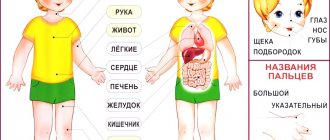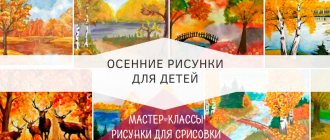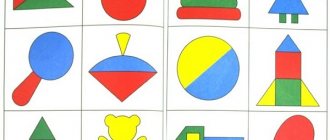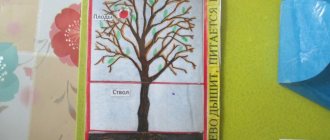In this article about trees you will find pictures, fairy tales, riddles and educational tasks for children. This is the first article in the series “Encyclopedia of Trees for Kids.” And in it we will get acquainted with three trees - oak, elm and ash. At the end of the article there is a presentation for children on the topic “Trees” for free download.
Welcome to the wonderful world of trees! I want to believe that you will make new discoveries in this world and love it! And once again admire the beauty and wisdom of nature, revealing its secrets for yourself and for your children.
All tasks are designed to be completed not in “one sitting,” but as the child gets acquainted with trees. We saw an oak tree while walking and talked about it. We looked at a drawing of tree leaves and their bark on the website; during a walk we looked at the bark of trees in the yard, and drew an individual drawing of the bark of each tree. We watched a cartoon and made up a fairy tale based on it, etc. Then the child will not just learn new information, but will apply it in life, study the world around him, ask questions, think, look for solutions, and grow into an inquisitive, independent, creative person!
I wish everyone interesting communication with the world of trees and new discoveries!
Oak in pictures, riddles, fairy tales and tasks for children
Guess a riddle. Why did you decide that it was an oak and not a birch or mountain ash?
Task 1. Speech game with coloring book “Oak”
Why is the oak called a giant? Why is he called a long-liver? (because it “lives a long time”) How else can you say about oak - what is it like? (Mighty, strong, big, huge, great, branchy, tall, thick, stocky, gnarled, curly, squat, spreading, spreading, thick, centuries-old, ancient, centennial, stately, majestic, old, young, etc.) .
Helpful Tips:
1. When choosing words, you can play this game with your child. Print out the "Oak" coloring page. In it, the oak crown is divided into parts (10 or more). You can draw a similar picture yourself. As soon as the child names the word, you paint over one of the parts (you need to paint over it quickly - so it’s better to use a marker). The task is to find many words about oak in order to paint over all parts. Such a task is interesting to the child, and he has a desire to find as many suitable words as possible. I often use this technique in teaching children, and it always gives excellent results! Gradually, you can divide the image into more and more parts, so the children will be able to easily cope with the task.
2. It will be difficult for the child to complete the task alone, so you name the most difficult, rarely occurring words, and the baby says simpler and more familiar words. By conducting such exercises, we enrich the child’s vocabulary and teach him to listen attentively to the speech of adults and the language of works of art, to remember expressive words, and to pay attention to them. If you constantly play such word selection games with your child, you will gradually begin to notice that the child begins to use very beautiful, bright, individual, figurative expressions in his speech!
3. If you are doing this exercise with several children or a group of kids, you can do it differently. Cut out leaves from colored cardboard (shaped like oak leaves) and apply them to the oak drawing. One word is equal to one leaf on an oak tree! It is necessary to calculate so that the leaves at the end of the task cover the entire crown. It is very convenient to do this exercise using Uni patafix - a means for repeatedly safely gluing parts. Attached and then easily removed! There are no stains or marks left, and the pictures are intact! Very convenient for games with children! I’ve been using it for twelve years now and recommend it to everyone! This plastic mass is sold in office supply stores and online stores.
Here's a coloring page for this exercise!
Task 2. Strong as oak. What does this expression mean?
They say about a strong, strong, healthy person: “He is as strong as an oak.” Why do they say this? Which fairy-tale characters can you say this about? (Remember the heroes from the works known to your child. You can tell about Russian heroes from epics or about the heroes of fairy tales who overcame obstacles and showed their prowess and strength in the fight against the Serpent Gorynych or Koshchei the Immortal, remember the brave soldier from many folk and author's fairy tales ). When you watch cartoons or read fairy tales, remember this expression from time to time and ask. about which of the heroes can this be said and why.
Task 3. The most seasoned! Watching while walking
Find an oak tree on your walk. Look at him, say hello to him.
Tell your child that in the fall the leaves of an oak tree fly away reluctantly and slowly, as if they are in no hurry to fly to the ground. And when the whole forest has flown around, the oak still has leaves. And some oak leaves do not fly off at all and remain on the branches for the winter. This is how Irina Tokmakova wrote about it in a poem.
The oak tree is not afraid of rain and wind at all. Who said that oak is afraid of catching a cold? After all, it remains green until late autumn. This means the oak is hardy, this means it is hardened.
Find acorns under the oak tree and examine them. Make a riddle.
Task 4. How does an oak tree grow from an acorn?
Look at the leaves and fruits of the oak tree (explain to your child that the fruits of an apple tree are apples, the fruits of a pear tree are pear fruits, and the fruits of an oak tree are acorns). What color are they? What shape? What are they like?
Invite your child to guess the riddle (don’t show the answer!).
Draw your child's attention to how interesting it was in the riddle about the acorn! “Beretik” was called a “scooper” in it, and what is a “box”? Why does this riddle say that there is an oak tree in the “box”, because the oak tree is large and will not fit in the acorn? (Listen and encourage any opinion of the child, the main thing is that he is trying to think, find reasons and relationships, learn to independently look for a solution in a new situation with an ambiguous answer!)
Ask: “Do you want to know what’s inside an acorn and how new young oak trees are made from acorns? Watch this little film “How an Oak Grows from an Acorn”!
An acorn fell from a branch to the ground, A ripe acorn, A heavy acorn. He cries and cries out of fear and does not hide his acorn tears. - What should I do, Giant Oak? Hey, answer me, I'm your son! - What should you do? Bury yourself in the ground so that by spring you can turn into an oak tree. (Leila Eradze)
Note: The kid will most likely be surprised in the first minute of the film that nothing happens to the acorn. Tell him that he needs to wait a little and be patient, because an oak tree does not immediately grow from an acorn. First, the acorn lies on the ground for a very long time, gets wet under water in moisture? it is covered and protected by snow in winter. And only then the first sprout appears from the acorn and begins to stretch upward.
Tell your child that you can grow an oak tree from an acorn at home if you plant the acorn in moist soil and water it every day. You can try to grow an oak tree yourself if you or your children have a desire. It will be interesting for children to see what happens. Take acorns from under a large, strong oak tree and plant them in regular flower soil in indoor pots. You can germinate acorns in damp cotton wool and then plant them in a pot. Water every day, the plant really needs moisture! Ask your child: “Who in nature waters an acorn?” (The rain helps it grow!) The sprout will appear no earlier than three weeks later. When the oak tree grows, you can transplant it outside. Do not under any circumstances throw away the trees after your germination experience! They are alive, and the baby should definitely see how they will be returned to nature! Of course, it is not at all necessary to grow an oak tree from an acorn yourself, but it always delights children when they see the shoots and their development!
Task 5. Playful breeze, or autumn leaves in pictures
Speech exercise to develop linguistic sense. Ask your child, start a phrase, and he will finish:
- The oak tree has oak leaves.
- What about aspen? -... aspen
- At the birch tree? - ... birch
- At the rowan tree? - ... rowan
- At the maple? - ... maple
- At the poplar? - ...poplar
If the child makes a mistake, then simply say “Such a word could be in Russian, but people call these leaves differently” and name it correctly. The child’s incorrect answer should not be repeated. When forming new words, the child is in the role of an experimenter-researcher, so mistakes here are not a loss, but let them develop! After all, you can’t learn to walk without falling!
Assignment for the child: Look carefully at the oak leaves again. Now try to find them in this picture - confusion. The autumn breeze mixed up all the leaves. Help me figure out where the oak leaves are. Where is the birch leaf? Aspens? Maple? Rowan trees?
The wind flew through the forest, The wind counted the leaves: Here is an oak one, Here is a maple one, Here is a carved rowan tree, Here is a golden one from a birch tree, Here is the last leaf from an aspen tree The wind threw it onto the path. N. Nishcheva
How many oak leaves are there in the picture? (Three - one with smoother edges, and two leaves with carved edges)
Note: this and other pictures in good quality for printing or displaying on the screen are given in the presentation below.
Task 6. What would happen if there were no trees?
“Let’s imagine what would happen if there were no trees?” (it would be very hot, there would be no shadow, the birds would fly away, the wind would blow, etc.). Try to fantasize further with your child: “Would there be no birds? Why is this bad? Maybe we could live without birds? (No, birds peck harmful insects, and then there would be too many of these bugs). “And if there were no trees on our streets, what would happen? Wouldn't there be a shadow? Why would that be bad? Maybe nothing bad would have happened? (It would be very hot outside, very dusty on the road, we wouldn’t be able to play in the heat during the day, etc.) After the child has reasoned with you and expressed his assumptions, let him watch a good cartoon about the boy Nazarka, old oak and birch: "Tales of the old oak." In this cartoon, your child will see why we need trees and how they help us!
https://youtu.be/cXqRN5bxFVs
And at the end of the conversation about our first tree - the oak, I want to tell you two tales about the oak. Kind and wise - the same as the character of the oak itself - a symbol of strength and wisdom.
Dmitry Chekhov "The Tale of the Old Oak"
In one dense forest lived a wise and old oak tree. Everyone respected him and called him the king of the forest. Young willows, birches and other trees loved to listen to the tales of the old tree.
Once the oak asked the trees: - Dear trees - lindens, maples, willows and the rest! - Would you like to listen to a fairy tale about our forest? - We want, we want! - all the young trees shouted joyfully. “Well, listen...” said the oak tree.
The wise oak began to tell: “In our forest, once upon a time there lived an old and proud stump.” This happened in the fall. One day his grandmother came to him with a basket, bowed to him and left. After some time, grandfather comes into the forest with a bag, also bows to the stump and leaves from there. And so people came with buckets and bowed to the stump.
Stop reading the fairy tale here and discuss with your child what kind of stump it was that everyone bowed to him? Have you and I ever bowed to a tree stump? And you will find out the answer further in the fairy tale - I wonder if you guessed it?
The stump then became proud and said to the trees standing around it: “Bow to me, I am your king!” But the trees did not bow to him. -You have a wonderful imagination! - said the tall Pine. - And the gift of acting in the theater! - said the wild cherry tree. - I am not kidding! - Today people came to me and bowed to me - you do the same! But the trees began to be indignant: “How can this be?” - said the wild apple tree. And then there was a terrible commotion. The trees were indignant, but the old stump still proved that he was the king.
But then, amid this commotion, a fast titmouse flew in and sat on a stump. She asked to tell what happened to the wild cherry. When the bird found out everything, she said: “Old stump!” You know that it’s autumn and that there are a lot of mushrooms in the forest. Look around you. And indeed, mushrooms could be seen around the stump: porcini, boletus, chanterelles and others. “I now understand why people bowed down in front of me!” - said the stump. - They were collecting autumn mushrooms! And the old stump no longer began to boast, he began to respect all the trees and the forest.
The wise oak finished telling the tale. - What a clever fairy tale! - said the owl, who also flew in to listen to the story. - Indeed, it happens to us too! — the young birch admired.
Everyone liked the tale of the wise oak, and since it was late in the evening, everyone fell asleep sweetly.
Hans Christian Andersen's fairy tale "The Last Dream of the Old Oak." Christmas tale
A fairy tale about life - more likely for adults than for children... More precisely, not only for children...
In the forest, high on a steep slope, on the open seashore, there stood an old, old oak tree, and it was exactly three hundred and sixty-five years old - a considerable period of time, but for a tree it’s the same as for us people, the same number of days. We are awake during the day, sleep and dream at night. With a tree the situation is different: the tree is awake for three seasons and falls asleep only in winter. Winter is his time of sleep, his night after a long day - spring, summer and autumn.
On warm summer days, mayflies danced around its crown; they lived, fluttered and were happy, and when one of these tiny creatures in quiet bliss fell to rest on a large fresh leaf, the oak tree said every time:
- Poor thing! Your whole life is just one day! So short... How sad!
- Sadly? - answered the mayfly. - What are you talking about? It’s so light, warm and wonderful all around! I am so glad!
- But just one day - and it’s over!
- End? - said the mayfly. - What's the end? And you too?
- No, maybe I’ll live thousands of your days, my day lasts entire seasons! You can’t even count how long it is!
- No, I don’t understand you! You have thousands of my days, and I have thousands of moments, and in each there is joy and happiness! Well, will all the beauty of the world die with your death?
“No,” answered the oak tree. - The world will exist much longer, endlessly, I can’t even imagine how long!
- So, that means you and I have been given equal amounts, we just count differently!
And the mayfly danced and whirled in the air, rejoicing in its delicate, graceful, transparent velvety wings, rejoicing in the warm air, filled with the smell of clover, rosehip, elderberry and honeysuckle. And how woodruff, primrose and mint smelled! The air was so fragrant that it was time to get drunk from it. What a long and wonderful day it was, full of joy and sweet sensations! And when the sun set, the fly felt such a pleasant tiredness, its wings refused to carry it, it quietly sank onto a soft swaying blade of grass, drooped its head and fell asleep sweetly. It was death.
- Poor things! - said the oak tree. - Their life is too short!
And every summer day the same dance was repeated, the same conversation, answer and falling asleep; This was repeated with entire generations of mayflies, and they were all equally cheerful, equally happy.
The oak was awake in its morning - spring, its noon - summer and its evening - autumn, it was time for him to fall asleep, and his night - winter was approaching.
Then the storms sang: “Good night! Good night! Here a leaf fell, there a leaf fell! We cut them off, we cut them off! Try to sleep! We will lull you to sleep, we will rock you to sleep! Isn't it true how good your old branches are? They are so aching with pleasure! Sleep sweetly, sleep sweetly! This is your three hundred and sixty-fifth night, because you are still like a one-year-old baby! Sweet dreams! The clouds are pouring snow, it will lie like a sheet, a soft blanket around your feet! Sleep sweetly, have pleasant dreams!”
And the oak threw off its leaves, getting ready to rest, preparing to fall asleep, spend the whole long winter in dreams, see in dreams pictures of what they had experienced, as people see them in dreams.
He, too, was once small, and an acorn was his cradle. By human reckoning he was now in his forties. There was no bigger, more magnificent tree in the forest than it. Its top rose high above all the trees and was visible from the sea from afar, serving as a sign for sailors. And the oak tree did not even know how many eyes were looking for it. Wood pigeons nested in its green crown, the cuckoo crowed, and in the fall, when its leaves seemed forged from copper, migratory birds sat on its branches to rest before setting off across the sea. But now, in winter, the oak tree stood without leaves, and one could see how curved and knotty its branches were; crows and jackdaws took turns sitting on them and talking about how difficult the time had come, how difficult it would be to get food in the winter.
On the night before Christmas, the oak tree had the most wonderful dream of its life. Let's listen!
He seemed to feel that the time had come for a holiday, he heard the ringing of bells around him, and dreamed of a warm, quiet summer day. He spread his mighty green crown wide; the sun's rays played between its branches and leaves, the air was filled with the aroma of herbs and bushes; colorful butterflies chased each other; the mayflies danced, as if everything existed only for their dancing and fun. Everything that the oak tree experienced and saw around itself from year to year now passed in front of it as if in a festive procession. He saw mounted knights and ladies of times past, with feathers on their hats and falcons on their arms. They drove through the forest, a hunting horn blew, dogs barked. He saw enemy soldiers in shiny armor and colorful clothes, with pikes and halberds; they pitched tents and then took them down. Campfires were blazing, people were singing and sleeping under the wide-spread branches of the oak tree. He saw happy lovers meeting here in the moonlight and carving the first letter of their names on its isser-green bark. Cheerful wandering apprentices used to hang zithers and Aeolian harps on its branches, and now they hung again and sounded so inviting again. Wood pigeons cooed, as if they wanted to tell how the tree felt, and the cuckoo crowed how many summer days it still had left to live.
And now, as if a new stream of life flowed in him from the smallest roots to the highest branches and leaves. And it seemed to him that he was stretching, he felt life and warmth in the roots there, underground, he felt his strength coming. It grew higher and higher, the trunk quickly, non-stop stretched upward, the crown became thicker, more magnificent, more spreading. And the more the tree grew, the more the joyful thirst grew in it to grow even higher, to rise to the very sun, sparkling and hot.
The top of the oak tree had already risen above the clouds, which were rushing below like flocks of migratory birds or white swans.
The oak tree saw with every leaf, as if everyone had eyes. He saw the stars in the middle of the day, and they were so big and shiny! Each one shone like a pair of clear, gentle eyes, reminiscent of other familiar eyes - the eyes of children and lovers who met under his crown.
The oak experienced wonderful, blissful moments. And yet he missed his forest friends... He so wanted all the other trees, all the bushes, herbs and flowers to rise with him, to feel the same joy, to see the same shine as he did. The mighty oak tree, even in these moments of blissful sleep, was not completely happy: it wanted to share its happiness with everyone - both small and large, and this feeling trembled in every branch, every leaf passionately and ardently, as if in a human breast.
The crown of the oak tree moved as if it was looking for something, as if it was missing something; he looked down and suddenly heard the smell of woodruff, and then an even stronger smell of honeysuckle and violets, and it even seemed to him that he heard a cuckoo.
And then the green tops of the forest peeked through the clouds. The oak saw other trees beneath it, they also grew and stretched upward; bushes and grass too. Some even uprooted themselves from the ground in order to fly faster. In front of everyone was a birch tree; like white lightning, its slender trunk rushed upward, its branches fluttered like green blankets and banners. All the forest plants, even the brown plumes of the reeds, rose to the clouds; birds flew after them with songs, and on a blade of grass, rippling in the wind like a long green ribbon, a grasshopper sat and played with its wing on its thin leg. May beetles hummed, bees buzzed, birds sang at the top of their lungs; everything in the sky sang and rejoiced.
“Where is the red water flower? Let him be with us too! - said the oak tree. “And a blue bell and a little daisy!”
Oak wanted to see everyone near him.
“We are here, we are here!” - was heard from all sides.
“What about last year’s beautiful woodruff? And the carpet of lilies of the valley that was spread here a year ago? And what about the wonderful wild apple tree and all those who decorated the forest for many, many years? If they had lived to see this moment, they would have been with us!”
“We are here, we are here!” - was heard in the heights, as if those who answered had flown right above him.
“No, how good it is, I just can’t believe it! - the old oak tree rejoiced. - They are all here with me, both small and large! Not one is forgotten! Is such happiness possible?
"Everything is possible!" - came the answer.
And the old oak tree, which had not stopped growing, suddenly felt that it was completely separated from the ground.
“Nothing could be better! - he said. - Now no bonds hold me back! I can fly to the very source of light and shine! And all my dear friends are with me! Both small and large - everything!”
"All!"
This is what the old oak dreamed about. And while he was dreaming, a terrible storm raged over the land and sea - it was on Christmas night. The sea rolled heavy waves onto the shore, the oak tree creaked and crackled and was uprooted at the very moment when he dreamed that he was being separated from the earth. The oak tree collapsed... Three hundred and sixty-five years of his life were now like one day for a mayfly.
On Christmas morning, as the sun rose, the storm subsided. Bells rang festively, blue smoke curled from all the chimneys, even from the chimney of the poorest hut, like sacrificial incense on the Druid holiday. The sea became more and more calm, and on the large ship, which had withstood the overnight storm, elegant Christmas flags were raised.
- But the tree is no longer there! The night storm crushed the old oak tree, our landmark on the shore! - said the sailors. - Who will replace him for us? Nobody!
This is the funeral speech, short, but spoken from the heart, that the sailors honored the old oak tree, which had been thrown into the snow by a storm. An ancient song sung by the sailors also reached the oak tree. They sang about Christmas, and the sounds of the song rose high, high to the sky, just as the old oak rose to it in its last dream.
Elm in pictures and tasks for children
Elm trees are often found on our streets. This is a very useful tree - it perfectly purifies the air. Birds also love elm very much - they peck its seeds.
Task 1. Parts of a tree. Why do trees need bark?
Ask your child: “What parts does a tree have? (Root, trunk, branches, leaves, buds open in spring, flowers appear, then fruits). Why does a tree need bark? Bark is to a tree as it is to us as clothing. Why do we need clothes? (It warms us, protects us from cold, from heat, from mosquitoes and midges). Likewise, the bark of trees protects them in winter instead of our fur coats and hats. And in summer it protects from heat, insects, dust, and water. Without bark, a tree dies or gets sick.”
The north wind, snowy, rushes towards them. -Where are your clothes, trees? Where are your hats and mittens? Make sure you don't catch a cold in the cold!
The snowdrifts will fall, there will be no paths, It will be cold for you without boots. The branches and roots will freeze. Who will feed you? Who will get you drunk? (L. Stepanov)
Trees don't always have bark. Southern trees may not have bark - they are already warm, because there is no cold winter in the south!
Task 2. Bark pattern
Each tree has its own bark pattern. You can even draw it. To do this, take a sheet of paper and a soft, simple pencil for a walk (the softer, the better it will work!). Place a sheet of paper on the bark and hold it tightly, and let the baby carefully stroke the surface of the paper. You will get a bark pattern on the paper. You can paste it into an album about different trees, and next to the bark drawings, paste photos of trees and their dried leaves.
Task 3. Leaves and seeds
Ask your child: “Why do trees need seeds?” Explain that seeds grow into new trees. Tree seeds are light and fly very far with the wind. There they fall to the ground and germinate, producing a beautiful new tree. Look how light, almost transparent the elm seeds are.
On a walk, find elms and show them to your child. Look closely at the leaves under the tree and find “which branch are these babies from,” that is, where are the elm leaves and where are the leaves of other trees. Don't tear off leaves to look at! The tree is alive!
Ask: “Why does a tree need leaves?” Give the baby the opportunity to touch the leaves, run his finger along their contour, along the surface of the leaf. Let the child touch the tips of the leaves - are they sharp or blunt? Which edge is jagged, carved or smooth?
Discuss where the leaves will go by spring? After all, there are many of them on earth now? But in the summer they are not there! No one removes leaves from the forest. Where are they? Tell us that leaves are very necessary for the soil, the earth, they give it nutrients. If the leaves are removed, the soil becomes poorer and depleted. Therefore, the autumn carpet of leaves on the ground must be preserved as it happens in nature in the forest. In the spring you can look for old leaves on the ground and show your baby how they turn into very dark, and then completely black.
Trees with names for children
The presented cards must be printed on thick paper and laminated for long-term use. Images include the plant itself, tree leaves with names for children.
When learning about flora, children learn that trees are divided into coniferous and deciduous. An adult should explain that the difference lies in the structure of the green parts: coniferous plants have evergreen needles, and deciduous plants have leaf blades that fall off in the winter. On the territory of our country, both trees grow and form deciduous, coniferous and mixed forests.
Deciduous trees growing in our area:
- birch;
- maple;
- oak;
- Rowan;
- poplar;
- willow;
- beech;
- ash;
- chestnut;
- alder;
- aspen;
- Linden;
- elm.
Children need to be explained that, in addition to forest species, there are deciduous fruit trees. In our area we grow:
- apple tree;
- pear;
- cherry;
- cherries;
- peach;
- apricot;
- cherry plum;
- plum
Coniferous trees in our country:
- spruce;
- Scots pine;
- Siberian cedar pine;
- larch;
- fir.
3.Ash in pictures and tasks for children
How slender and beautiful you are, our dear tall ash tree! Decorating the forests, how green and shady you are! Up to fifteen leaflets form a compound leaf. Yu. Nasimovich
Task 1. Why is ash called that?
Ash has a very beautiful name: ash. And even earlier it was called ash tree, ash tree and even ash tree. What word do all these words resemble? On the word "clear". Why was ash called that? The secret is in its leaves.
Let's look at the leaves of the ash tree. They are very similar to rowan leaves. How are they similar?
How are they different? (The rowan tree has narrower and more carved leaves. And the ash tree has wider leaves than the rowan tree)
Ash has sparse leaves, with gaps between them. Therefore, it has a light, openwork, light crown of leaves. That is why it is called “clear” - “ash”.
Ash is an amazing tree! Its leaves fall in late autumn and often fall straight green to the ground. Listen to a fairy tale about why the ash tree does not show off its golden attire for a long time in the fall, but sheds it quickly, even with green leaves:
The Tale of the Ash Tree
Now spring has come, all the trees and bushes are full of beautiful leaves and bright flowers.
Only the ash tree stands bare, as if in a cold winter. God deprived him of his sight, and the poor fellow had no idea that spring had come and brought joy to everyone.
The birch tree has long woven its ruffled, heart-shaped leaves, and the oak tree has long had its beautiful jagged leaves ready. The trees ask, why doesn’t the ash tree sew itself a festive outfit?
- Has spring come yet? - Ash was surprised.
“Spring has come a long time ago,” the trees told him.
Then the ash tree began to hastily prepare its festive outfit - foliage. But in a hurry, he was unable to make the leaves even and beautiful, and they turned out angular, with deep notches.
In the autumn, when the north wind blew, the ash tree asked the trees:
- Autumn will come soon?
“Yes, she’s already here,” answered the trees.
Ash heard this, and he didn’t want to be a laughing stock for everyone again. So he threw off all the foliage at once. Other trees are still lushly decorated with leaves, but the blind ash tree stands bare, and the north wind rages in its branches.
Ash is also called the “goat tree.” How do you think why? Sheep and goats love its leaves, and by feeding on ash leaves, goats’ milk becomes more tasty!
Ash is a tree that loves to be friends with other trees - elm, maple! And very often it is friends with the oak tree - it grows next to it.
Children are also friends with ash trees. They love to make crafts and toys from its seeds.
Task 2. What happened in the forest? Make up a story
What happened to the maples? They nodded their crowns. And the tall oaks seemed to stand on their hind legs. And the hazel tree itself is not itself rustling with thick foliage. And the ash tree whispers barely audibly: I don’t agree, I don’t agree!
What happened in the forest? What do you think the name of this poem is? Why did the trees suddenly start talking? What were they talking about? If your child is interested, you can compose a fairy tale together with him: “What were the trees talking about?” and draw pictures for it. And this poem is called “Wind in the Forest,” written by Agnia Lvovna Barto.
Task 3. Ash seeds
Birds are friends with ash trees. In winter they often sit on ash tree branches. How do you think why? What attracts them? That's right, seeds! Look with what pleasure the bullfinch takes ash seeds in winter! This is his lunch!
Our first journey into the world of trees has ended! See you again on the “Native Path!” You can download pictures of this article in high quality and good resolution in the form of a presentation in our VKontakte group “Child development from birth to school” (see the group section “Documents” under the group videos). The presentation can be edited.
Description of trees for children
In addition to pictures, you should prepare a description of trees for classes. There is no need to overload preschoolers with scientific calculations about plants; a general description and interesting facts are enough.
For example, you can say about the birch tree that it is one of the symbols of Russia. Her beauty has long been compared to that of a young girl. The white bark of a birch is not for decoration, it is protection against sunburn. In ancient times, baskets and other household items were made from birch bark.
Oak is a strong tree, a symbol of male strength, health and longevity. Its fruits are acorns, which deer and wild boars love to feast on.
Willow is also called willow, willow, willow. It is called weeping because of its thin branches hanging over the water, as if a tree is crying. Willow grows only near bodies of water. In ancient times, people were engaged in dowsing - they looked for underground water using willow twigs in order to dig wells in this place.
Horse chestnut is the most beautiful park tree in our country. Its white flowers are collected in large pyramidal inflorescences. The plant got its name because on its ripe brown fruits there is a noticeable pale spot, reminiscent of the mark of a horse's horseshoe.
Maple is the most elegant autumn tree. Its carved leaves turn a variety of shades in autumn, from gold to burgundy.
Linden is the main honey plant. Linden honey is rich in beneficial substances. Linden tea is recommended for colds.
The saying “trembles like an aspen leaf” is associated with aspen. Its leaves are dense and rounded, with a long petiole. The slightest breeze is enough for them to begin to tremble, rub against each other, and rustle.
Poplar is known for its fluff that covers the asphalt in June. Poplar fluff is small tree achenes covered with the finest fibers.
The spruce is the main symbol of Christmas. This is an evergreen species; the needles do not fall off before the arrival of winter.
Larch is the only deciduous coniferous species. She changes her needles every year.
Cedar, or more correctly cedar pine, is known for its delicious and extremely healthy nuts, rich in oils and vitamins.








